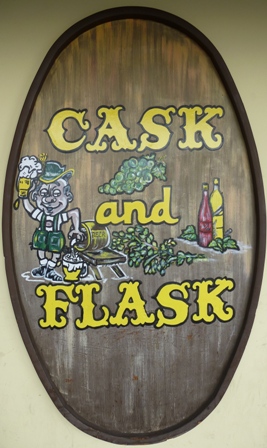 Today is a personal anniversary of sorts — on this date in 2007, I walked into Cask & Flask Liquors, located in the McKinleyville Shopping Center, right next to the Safeway grocery store, in McKinleyville, California — about two miles, maybe less, from the Pacific Ocean — and applied for a job.
Today is a personal anniversary of sorts — on this date in 2007, I walked into Cask & Flask Liquors, located in the McKinleyville Shopping Center, right next to the Safeway grocery store, in McKinleyville, California — about two miles, maybe less, from the Pacific Ocean — and applied for a job.
Nothing unusual so far, but it quickly turned strange.
The owner was behind the counter, and in a move that’s way-highly-unusual for the circumstance, hired me on the spot. So I trotted around that counter and started work.
People don’t normally get hired in such a way — without any knowledge of who I was, or what kind of background, or anything, the owner opened the register, the liquor stock and all the intimate particulars of a business to a complete and total stranger.
Although I’d already dropped off a resume, it was apparent the owner hadn’t seen it.
Now seven years later, I’m getting ready to call it quits — retiring at the end of this summer.
(Illustration found here).
The owner apparently had some personal problems — he was in the middle of a spousal spat, which led eventually to the estranged wife taking control of Cask & Flask in December 2007, which about that same time, a UK economics professor said if people don’t get their financial shit together, it’s gonna get bad, real bad: “They still have another couple of months before this starts imploding. Things are very unstable and can move incredibly fast. I don’t think the central banks are going to make a major policy error, but if they do, this could make 1929 look like a walk in the park.”
Despite that uplifting crap, she’s kept it running ever since, and has done an outstanding job, considering what happened to the economy.
In June 2007, the outerwear of the financial world was picture perfect, but the innards were about to go POW!
A deep, fatal tear in the bubble was already hissing.
From CNN Money in August 2007:
The hedge funds’ troubles started in April, worsened in May, and by mid-June had become a full-blown crisis.
Even Bear’s injection of $1.6 billion couldn’t save them.
By mid-July both were next to worthless.
Less than three weeks later, the stock was way down, Spector was gone, and Bear was selling more than $2 billion in debt — both to shore up its balance sheet and to demonstrate that its assets were still valued.
So back to that very day I walked into Cask & Flask looking for employment — action producing maybe a nasty, mutant-butterfly effect:
On June 22, 2007, Bear Stearns pledged a collateralized loan of up to $3.2 billion to “bail out” one of its funds, the Bear Stearns High-Grade Structured Credit Fund, while negotiating with other banks to loan money against collateral to another fund, the Bear Stearns High-Grade Structured Credit Enhanced Leveraged Fund.
— from Wikipedia.
Some say the actual, real start to the 2008 financial meltdown.
To oversimplify the Bear Stearns situation, the subprime mortgage-backed securities market behaved well outside of what the portfolio managers expected, which started a chain of events that imploded the fund.
…
Unfortunately, the Bear Stearns portfolio managers failed to expect these sorts of price movements and, therefore, had insufficient credit insurance to protect against these losses. Because they had leveraged their positions substantially, the funds began to experience large losses.
— online post Sep 6, 2007 at investopedia.com.
And the rest is history, as they say.
Demise of Bear Stearns, considering the obscene amounts of so-called money sought after and thrown around near-random, was most-rapid and domino-like — in just more than a year, an 80-year-old “Most Admired” global investment bank worth billions simply ceased to exist.
Then in March 2008, after a weekend of intense negotiations, the Federal Reserve approved a $30 billion credit line to help JPMorgan Chase acquire Bear.
Reflecting Bear’s dire straits, JPMorgan agreed to pay only about $270 million in stock for the firm, which had run up big losses on investments linked to mortgages.
JPMorgan agreed to pay a mere $2 a share to buy all of Bear — less than one-tenth the firm’s market price two days before.
The price was later raised to $10 a share.
— New York Times
And the financial blow-out overall — from Bloomberg: So if one adds $7.6 trillion of “actual” losses and $5.2 trillion in “avoided” losses, there’s an estimated grand total of $12.8 trillion in costs for the crisis.
And the old Cask & Flask suffered greatly, too. Although the hardest impact of the meltdown didn’t effect us for a couple of years, ultimately the business lost a shitload of moneyed customers — no longer cash-heavy people buying high-price Glenfiddich or Patrón or expensive wines, now it’s just bottom-feeders looking for cheap vodka.
In October 2009, I was made manager of the store, there it’s been ever more. This is the longest I’ve ever worked anywhere since starting work at age 16, and the scenario is starting to crack.
I wrote a bit about it on Friday — here if you’re interested.
As a 65-year-old, I think it’s time to put a lid on the flask, and roll the cask away.
Drink up, everybody — pleze!